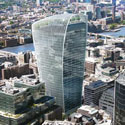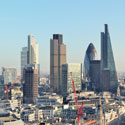Filter by
You must be a CTBUH Member to view this resource.
20 Fenchurch Street
The Walkie Talkie, 13-23 Fenchurch Street
Building
Completed, 2014
EC3M 4BA
office
composite
BREEAM Excellent
160.1 m / 525 ft
36
2
16
6 m/s
104,516 m² / 1,125,001 ft²
You must be a CTBUH Member to view this resource.
You must be a CTBUH Member to view this resource.
Proposed
Construction Start
Completed
Usually involved in the front end design, with a "typical" condition being that of a leadership role through either Schematic Design or Design Development, and then a monitoring role through the CD and CA phases.
Usually takes on the balance of the architectural effort not executed by the "Design Architect," typically responsible for the construction documents, conforming to local codes, etc. May often be referred to as "Executive," "Associate," or "Local" Architect, however, for consistency CTBUH uses the term "Architect of Record" exclusively.
The Design Engineer is usually involved in the front end design, typically taking the leadership role in the Schematic Design and Design Development, and then a monitoring role through the CD and CA phases.
The main contractor is the supervisory contractor of all construction work on a project, management of sub-contractors and vendors, etc. May be referred to as "Construction Manager," however, for consistency CTBUH uses the term "Main Contractor" exclusively.
Other Consultant refers to other organizations which provided significant consultation services for a building project (e.g. wind consultants, environmental consultants, fire and life safety consultants, etc).
These are firms that consult on the design of a building's façade. May often be referred to as "Cladding," "Envelope," "Exterior Wall," or "Curtain Wall" Consultant, however, for consistency CTBUH uses the term "Façade Consultant" exclusively.
Material Supplier refers to organizations which supplied significant systems/materials for a building project (e.g. elevator suppliers, facade suppliers, etc).
You must be a CTBUH Member to view this resource.
Usually involved in the front end design, with a "typical" condition being that of a leadership role through either Schematic Design or Design Development, and then a monitoring role through the CD and CA phases.
Usually takes on the balance of the architectural effort not executed by the "Design Architect," typically responsible for the construction documents, conforming to local codes, etc. May often be referred to as "Executive," "Associate," or "Local" Architect, however, for consistency CTBUH uses the term "Architect of Record" exclusively.
The Design Engineer is usually involved in the front end design, typically taking the leadership role in the Schematic Design and Design Development, and then a monitoring role through the CD and CA phases.
The Design Engineer is usually involved in the front end design, typically taking the leadership role in the Schematic Design and Design Development, and then a monitoring role through the CD and CA phases.
The main contractor is the supervisory contractor of all construction work on a project, management of sub-contractors and vendors, etc. May be referred to as "Construction Manager," however, for consistency CTBUH uses the term "Main Contractor" exclusively.
Other Consultant refers to other organizations which provided significant consultation services for a building project (e.g. wind consultants, environmental consultants, fire and life safety consultants, etc).
These are firms that consult on the design of a building's façade. May often be referred to as "Cladding," "Envelope," "Exterior Wall," or "Curtain Wall" Consultant, however, for consistency CTBUH uses the term "Façade Consultant" exclusively.
Material Supplier refers to organizations which supplied significant systems/materials for a building project (e.g. elevator suppliers, facade suppliers, etc).
Warm Weather Spaces Walking Tours 2015
17 September 2015 - Event
Inaugural Japan Symposium Rises to the Occasion in Tokyo
22 May 2015 - Event

17 October 2016 | London
CTBUH Video Interview – Claude Bojer Godefroy
Claude Bojer Godefroy of Henning Larsen Architects is interviewed by Chris Bentley during the 2016 CTBUH China Conference. Claude discusses the design process for interior...

01 January 2017
20 Fenchurch Street, London, UK
20 Fenchurch Street, located in the financial district of the City of London, was designed by architect Rafael Viñoly. The building has been nicknamed the...

17 October 2016 | London
CTBUH Video Interview – Claude Bojer Godefroy
Claude Bojer Godefroy of Henning Larsen Architects is interviewed by Chris Bentley during the 2016 CTBUH China Conference. Claude discusses the design process for interior...

13 January 2016 | London
Building Maintenance Units on 20 Fenchurch, London
This video shows the impressive solution devised by CoxGomyl to install Building Maintenance Units (BMUs) to maintain the facade on this distinctive curved structure designed...

27 October 2015 | London
Cormac MacCrann of Canary Wharf Group is interviewed by Chris Bentley during the 2015 CTBUH New York Conference at the Grand Hyatt New York. Cormac...

26 October 2015 | London
Challenges and Benefits of Integrating Public Space into Tall Buildings
The integration of publicly accessible amenities into tall buildings is a desirable approach to expand the use of a given building to ever-broader segments of...

12 June 2013 | London
Rafael Viñoly of Rafael Viñoly Architects is interviewed by Jeff Herzer during the 2013 CTBUH London Conference at The Brewery, London. Rafael talks about Battery...

11 June 2013 | London
Breaking the Mold while Embracing Context in Historic Cities
The pieces of architecture which we place in cities are not singular objects but parts of a greater whole – which, once existing, will either...

11 June 2013 | London
Vince Ugarow of Hilson Moran is interviewed by Jeff Herzer during the 2013 CTBUH London Conference at The Brewery, London. Vince talks about building systems...

11 June 2013 | London
Matching Occupier and Landlord Needs: Supply and Demand in Tall Buildings
As employee habits increasingly change and alternative workplace solutions become a reality, what do tenants want from their tall buildings and how is this affecting...

01 January 2017
20 Fenchurch Street, London, UK
20 Fenchurch Street, located in the financial district of the City of London, was designed by architect Rafael Viñoly. The building has been nicknamed the...

26 October 2015
Challenges and Benefits of Integrating Public Space into Tall Buildings
The integration of publicly accessible amenities into tall buildings is a desirable approach to expand the use of a given building to ever-broader segments of...

26 October 2015
The Promise of Public Realm: Urban Spaces in the Skyscraper City
This paper will reveal the importance of integrating the Ground Plane, Mid-Level and Rooftop Urban Public Spaces in the City. We will explore the NYLON...

11 June 2013
The Special Nature of the European Skyscraper
European architecture is at a crossroads. Its commercial and environmental realities are driving buildings ever-higher, but not all are convinced. In this article – contributed...

27 April 2012
Debating Tall: Is UNESCO Going Too Far?
Controversy has erupted over development proposals in London and Liverpool in the UK, which UNESCO says will damage views of World Heritage sites. Critics counter...

05 November 2007
The Economics of Supertall Towers
This paper addresses global economic factors infl uencing the decisions leading to the development of super-tall towers, including population growth and urbanization, economic cycles and...
17 September 2015
The CTBUH Urban Habitat / Urban Design Committee organized guided walking tours of 16 cities around the globe, focusing on urban habitats around tall buildings.
22 May 2015
CTBUH held its inaugural Japan Symposium at the Academy Hills lecture hall of the Mori Tower in Roppongi Hills, bringing together leading experts
29 January 2015
The new CTBUH Urban Habitat / Urban Design Committee organized a highly successful Winter Spaces Walking Tour in seven cities around the world.
13 June 2013
Set to complete in 2014, 20 Fenchurch Street is already a feature of the London skyline. The 38-story, 177-meter tower has been nicknamed “The Walkie Talkie” because of its distinctive shape.
Subscribe below to receive periodic updates from CTBUH on the latest Tall Building and Urban news and CTBUH initiatives, including our monthly newsletter. Fields with a red asterisk (*) next to them are required.
View our privacy policy